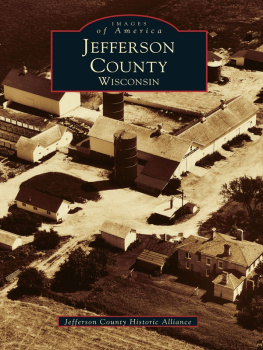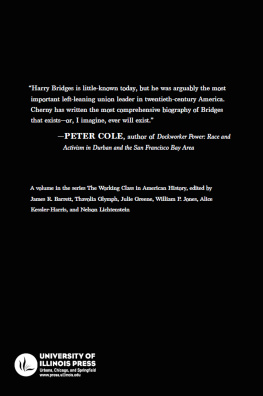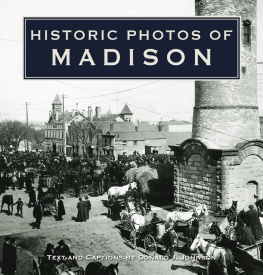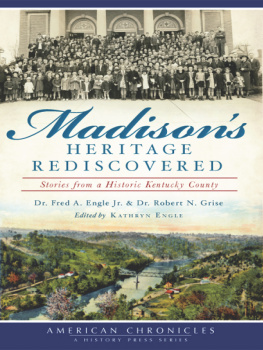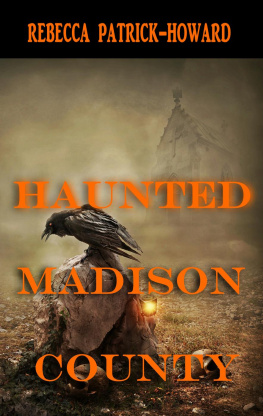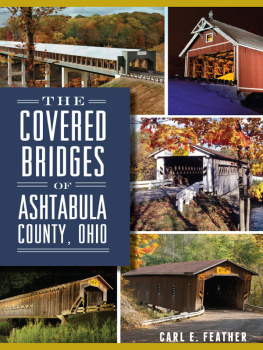THE BRIDGES OF MADISON COUNTY
by Robert James Waller
There are songs that come free from the blue-eyed grass, from the dust of a thousand country roads. This is one of them. In late afternoon, in the autumn of 1989, Im at my desk, looking at a blinking cursor on the computer screen before me, and the telephone rings.
On the other end of the wire is a former Iowan named Michael Johnson. He lives in Florida now. A friend from Iowa has sent him one of my books. Michael Johnson has read it; his sister, Carolyn, has read it; and they have a story in which they think I might be interested. He is circumspect, refusing to say anything about the story, except that he and Carolyn are willing to travel to Iowa to talk with me about it.
That they are prepared to make such an effort intrigues me, in spite of my skepticism about such offers. So I agree to meet with them in Des Moines the following week. At a Holiday Inn near the airport, the introductions are made, awkwardness gradually declines, and the two of them sit across from me, evening coming down outside, light snow falling.
They extract a promise: If I decide not to write the story, I must agree never to disclose what transpired in Madison County, Iowa, in 1965 or other related events that followed over the next twenty-four years. All right, thats reasonable. After all, its their story, not mine.
So I listen. I listen hard, and I ask hard questions. And they talk. On and on they talk. Carolyn cries openly at times, Michael struggles not to. They show me documents and magazine clippings and a set of journals written by their mother, Francesca.
Room service comes and goes. Extra coffee is ordered. As they talk, I begin to see the images. First you must have the images, then come the words. And I begin to hear the words, begin to see them on pages of writing. Sometime just after midnight, I agree to write the storyor at least attempt it.
Their decision to make this information public was a difficult one for them. The circumstances are delicate, involving their mother and, more tangentially, their father. Michael and Carolyn recognized that coming forth with the story might result in tawdry gossip and unkind debasement of whatever memories people have of Richard and Francesca Johnson.
Yet in a world where personal commitment in all of its forms seems to be shattering and love has become a matter of convenience, they both felt this remarkable tale was worth the telling. I believed then, and I believe even more strongly now, they were correct in their assessment.
In the course of my research and writing, I asked to meet with Michael and Carolyn three more times. On each occasion, and without complaint, they traveled to Iowa. Such was their eagerness to make sure the story was told accurately. Sometimes we merely talked; sometimes we slowly drove the roads of Madison County while they pointed out places having a significant role in the story.
In addition to the help provided by Michael anal Carolyn, the story as I tell it here is based on information contained in the journals of Francesca Johnson; research conducted in the northwestern United States, particularly Seattle and Bellingham, Washington; research carried out quietly in Madison County, Iowa; information gleaned from the photographic essays of Robert Kincaid; assistance provided by magazine editors; detail supplied by manufacturers of photographic films and equipment; and long discussions with several wonderful elderly people in the county home at Barnesville, Ohio, who remembered Kincaid from his boyhood days.
In spite of the investigative effort, gaps remain. I have added a little of my own imagination in those instances, but only when I could make reasoned judgments flowing from the intimate familiarity with Francesca Johnson and Robert Kincaid I gained through my research. I am confident that I have come very close to what actually happened.
One major gap involves the exact details of a trip made across the northern United States by Kincaid. We knew he made this journey, based on a number of photographs that subsequently were published, a brief mention of it by Francesca Johnson in her journals, and handwritten notes he left with a magazine editor. Using these sources as my guide, I retraced what I believe was the path he took from Bellingham to Madison County in August of 1965. Driving toward Madison County at the end of my travels, I felt I had, in many ways, become Robert Kincaid.
Still, attempting to capture the essence of Kincaid was the most challenging part of my research and writing. He is an elusive figure. At times he seems rather ordinary. At other times ethereal, perhaps even spectral. In his work he was a consummate professional. Yet he saw himself as a peculiar kind of male animal becoming obsolete in a world given over to increasing amounts of organization. He once talked about the merciless wail of time in his head, and Francesca Johnson characterized him as living in strange, haunted places, far back along the stems of Darwins logic.
Two other intriguing questions are still unanswered. First, we have been unable to determine what became of Kincaids photographic files. Given the nature of his work, there must have been thousands, probably hundreds of thousands, of photographs. These never have been recovered. Our best guessand this would be consistent with the way he saw himself and his place in the worldis that he destroyed them prior to his death.
The second question deals with his life from 1975 to 1982. Very little information is available. We know he earned a sparse living as a portrait photographer in Seattle for several years and continued to photograph the Puget Sound area. Other than that, we have nothing. One interesting note is that all letters mailed to him by the Social Security Administration and Veterans Administration were marked Return to Sender in his handwriting and sent back.
Preparing and writing this book has altered my world view, transformed the way I think, and, most of all, reduced my level of cynicism about what is possible in the arena of human relationships. Coming to know Francesca Johnson and Robert Kincaid as I have through my research, I find the boundaries of such relationships can be extended farther than I previously thought. Perhaps you will have the same experience in reading this story.
That will not be easy. In an increasingly callous world, we all exist with our own carapaces of scabbed-over sensibilities. Where great passion leaves off and mawkishness begins, Im not sure. But our tendency to scoff at the possibility of the former and to label genuine and profound feelings as maudlin makes it difficult to enter the realm of gentleness required to understand the story of Francesca Johnson and Robert Kincaid. I know I had to overcome that tendency initially before I could begin writing.
If, however, you approach what follows with a willing suspension of disbelief, as Coleridge put it, I am confident you will experience what I have experienced. In the indifferent spaces of your heart, you may even find, as Francesca Johnson did, room to dance again.
Summer 1991
On the morning of August 8, 1965, Robert Kincaid locked the door to his small two-room apartment on the third door of a rambling house in Bellingham, Washington. He carried a knapsack full of photography equipment and a suitcase down wooden stairs and through a hallway to the back, where his old Chevrolet pickup truck was parked in a space reserved for residents of the building.
Another knapsack, a medium-size ice chest, two tripods, cartons of Camel cigarettes, a Thermos, and a bag of fruit were already inside. In the truck box was a guitar case. Kincaid arranged the knapsacks on the seat and put the cooler and tripods on the floor. He climbed into the truck box and wedged the guitar case and suitcase into a corner of the box, bracing them with a spare tire lying on its side and securing both cases to the tire with a length of clothesline rope. Under the worn spare he shoved a black tarpaulin.



